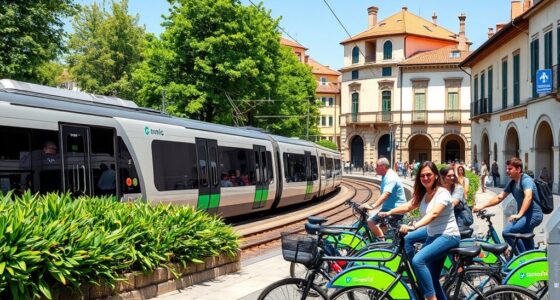To apply circular economy principles at home and during travel, focus on extending product life, reducing waste, and choosing sustainable options. Repair and reuse items whenever possible, select products made from recyclable and eco-friendly materials, and prioritize brands with transparent sustainability practices. Be mindful of resource use, such as conserving water and energy, and minimize packaging. Small, consistent actions can have a big impact—exploring more ways to embrace these principles will help you make even more eco-conscious choices.
Key Takeaways
- Design products for reuse, repair, and recycling to extend their lifecycle and minimize waste in home and travel contexts.
- Choose sustainable materials and transparent brands that prioritize resource efficiency and environmental impact.
- Reduce resource consumption by adopting practices like minimal packaging, energy conservation, and water-saving measures.
- Promote sharing, repairing, and repurposing items to create a circular flow of resources and reduce disposal needs.
- Educate on product life cycles and sustainable choices to foster responsible consumption aligned with circular economy principles.

Have you ever wondered how we can reduce waste and make better use of resources? Embracing the principles of a circular economy offers practical ways to do just that, especially when applying them to your home and travel habits. One of the key concepts is sustainable design, which focuses on creating products and spaces that minimize environmental impact throughout their lifecycle. When you choose sustainable design, you’re actively supporting resource management by selecting items that are durable, repairable, and recyclable. For instance, opting for furniture made from recycled materials or appliances with long-lasting warranties ensures you’re not contributing to unnecessary waste. In your home, this might mean rethinking how you purchase and dispose of items, favoring quality over quantity and avoiding single-use products whenever possible.
Resource management becomes even more critical as you navigate daily life and travel. By being mindful of how you use resources—water, energy, packaging—you’re directly participating in reducing your environmental footprint. Simple steps like installing water-saving fixtures, turning off unused electronics, and choosing eco-friendly cleaning supplies help conserve essential resources. When you travel, you can extend this mindset by choosing accommodations that prioritize sustainability or by bringing reusable items like bottles and utensils to cut down on waste. Carrying a reusable bag for shopping or packing lightly to reduce transportation emissions are small actions that add up over time. Additionally, understanding the importance of emotional alignment can help you maintain a positive mindset and stay motivated in your sustainable efforts.
Be mindful of resource use—conserve water, energy, and packaging to reduce your environmental footprint during daily life and travel.
Applying circular economy principles to your routines also involves repairing and reusing instead of discarding. If a household item breaks, consider repairing it or repurposing parts instead of immediately replacing it. When traveling, you might carry versatile clothing options that can serve multiple purposes, reducing the need for excessive packing and waste. Additionally, being conscious of packaging—opting for products with minimal or biodegradable packaging—helps prevent unnecessary landfill contributions.
Educating yourself about product life cycles and the environmental impact of materials enables smarter choices. When shopping, prioritize brands that adhere to sustainable practices and transparent resource management policies. This awareness supports a shift toward a more circular approach, where products are designed to be reused, refurbished, or recycled at the end of their life. By integrating sustainable design principles into your home and travel habits, you’re not only reducing waste but also fostering a more resilient and responsible relationship with the environment. Every small action, from the way you purchase to how you dispose of items, plays a essential role in advancing the circular economy and creating a more sustainable future.
Frequently Asked Questions
How Can I Start Implementing Circular Economy Principles at Home?
You can start implementing circular economy principles at home by practicing DIY repair to extend your belongings’ lifespan. Opt for sustainable shopping by choosing products made from eco-friendly materials and that are designed to last. Repair instead of replace whenever possible, and donate or resell items you no longer need. These actions help reduce waste and promote reuse, aligning your habits with a more sustainable, circular approach to home living.
What Are Some Common Challenges in Adopting Circular Economy Practices?
You might face challenges like recycling barriers, which make it hard to reuse materials effectively, and changing consumer habits that resist new practices. These issues often stem from lack of awareness or convenience. To overcome them, you can educate yourself on proper recycling, find sustainable alternatives, and gradually shift your routines. Staying committed helps you adapt, making it easier to adopt circular economy practices at home and in travel.
How Does a Circular Economy Impact My Household Budget?
A circular economy can be a silver lining for your household budget. By focusing on waste reduction and reusing resources, you’ll likely see significant cost savings over time. Less money spent on disposable items means more funds for other priorities. It’s like planting a seed that grows into savings, transforming your home into a more sustainable space while keeping your expenses in check. Embrace the change and watch your wallet thrive.
Are There Specific Products Designed for Circular Use in Travel?
Yes, there are products specifically designed for circular use in travel. You can choose reusable travel gear, like eco-friendly water bottles and utensils, that last longer and reduce waste. Additionally, look for circular luggage designs made from recycled materials or modular components you can repair or upgrade. These products help you travel sustainably while supporting the principles of a circular economy, reducing environmental impact.
How Can Travel Destinations Promote Circular Economy Principles?
Travel destinations can promote circular economy principles by encouraging visitors to participate in local recycling programs and choosing eco-friendly accommodations. You can support businesses that prioritize sustainable practices, such as reusing resources and minimizing waste. By doing so, you help reduce environmental impact and foster community sustainability. Your choices influence local efforts, making destinations more circular and environmentally responsible, ultimately benefiting both the planet and future travelers.
Conclusion
By applying circular economy principles to your home and travel, you’re like a gardener nurturing a thriving, sustainable garden. Every small action—reusing, recycling, reducing waste—adds up to a healthier planet. Embrace these practices, and you’ll help create a more resilient world, where resources bounce back instead of breaking down. Remember, your choices ripple outwards, making a big difference just like a single drop creates waves across a pond.









